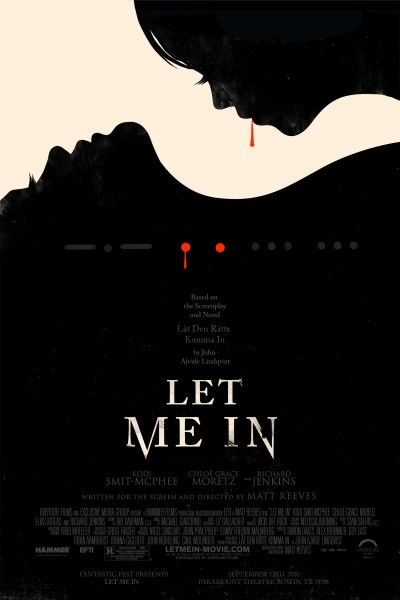When a film that gathers an enormous following and a smattering of praise has an American remake announced the same year it is released, you would expect a few groans. That is exactly what happened with Matt Reeves’ Let Me In, an adaptation and reworking of both the book and film named Let The Right One In. With that in mind, expectations weren’t high for the film, but it largely succeeds despite apprehension from most of the film-going community and works as a personal and touching tale, just in a different locale. Join me after the break for my full review of the faults and successes of this remake.
We start off with a mysterious man being rushed to the hospital through the snow covered winding New Mexico landscape. We don’t know why or what has happened, but the score let’s us know this is a scene of tension that we have been plopped into the middle of, and it is emphasized by the fact that the man is handcuffed to the railings of his stretcher. As “The Policeman” (Elias Koteas) prods for information from the mysterious victim, we are reverted back to a few weeks before. Owen (Kodi Smit-McPhee) is viewing neighbors in his apartment complex from his second floor window and witnesses “The Father” (Richard Jenkins) and Abby (Chloe Moretz) move into his apartment late one night. However, Abby isn’t your typical youth, and as her budding friendship with the increasingly lonely and bullied Owen begins to take form, the danger for all involved builds until it spills over.
The story is one of loneliness and how naïve we can be in our youth. So much so that by the time you form a friendship, and then realize that person is not normal (or, in this case, a vampire), we act like this doesn’t change the long-term outlook; when you are that young, you don’t worry about the future, you just live in the moment. While this is a story that has been told before, it was not in this locale, and it certainly did not seclude our main character to this degree. Owen truly has no other friends to count on when we are introduced to him, save for the gym teacher Mr. Zoric, who has about two minutes of screen time. This would be a suffocating situation if it wasn’t for the intriguing relationship between him and Abby, which helps bring a little humor and protection to Owen.
One of the more unique qualities of Let Me In is how the scenes in snow covered New Mexico feel warm, despite the obvious cold. The chemistry between Owen and Abby, although awkward at first, starts to gain traction and cinematographer Greig Fraser manages to capture warmth where it simply doesn’t exist when the two are on screen. Additionally, the camera work in a scene where “The Father” is tossed around inside of a vehicle as it rolls into a ditch is truly horrifying and a showcase piece. This use of practical effects brings me to my first major concern with the film.
When CGI is used sparingly and in the background, it can have a tremendous benefit on screen. However, when Abby’s feral mode kicks into high gear, she becomes a CGI blur and the carefully setup ‘80s aesthetic is completely shattered. When CGI looks fake it rouses me from the moment; my trust that this is a real situation is completely demolished. Unfortunately, while the CGI is used only a handful of times, it happens to be the key moments of Abby’s vampire attacks that are supposed to have an emotional punch, but instead feel like a gentle nudge. This is a kind and innocent girl that also is a monster, but that aspect is lost in the shuffle of wild special effects. This truly is a major aspect of the story, and why the first film is exceedingly brilliant; there is a perfect marriage between the horror genre and the drama that serves as the backbone of the film.
Despite my major gripe with the CGI, there are some golden aspects of the film that are haunting. Richard Jenkins portrayal of “The Father” is incredible and he has a detached and sad resonance that floods each scene. Additionally, Michael Giacchino’s pounding score provides an unrelenting tension throughout the film that emphasizes the potential danger for anyone. Director Matt Reeves also captures a great childlike awkwardness between Abby and Owen, particularly while they bob their head to music.
Ultimately, fears that Reeves would turn Let Me In into some mainstream thriller or horror film were completely unfounded. What he has done is create a deeply personal and resonant film that has one glaring flaw that keeps it from cementing itself as a true classic in its own right. Let Me In is a stirring study of loneliness in an age where personal contact was one of the only methods of companionship that could be formed but ultimately misses hitting the homerun it could have.
Final score: B+



